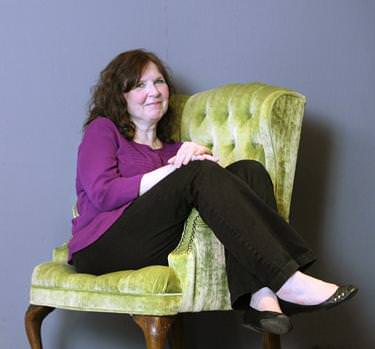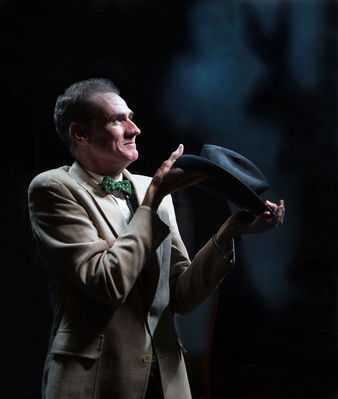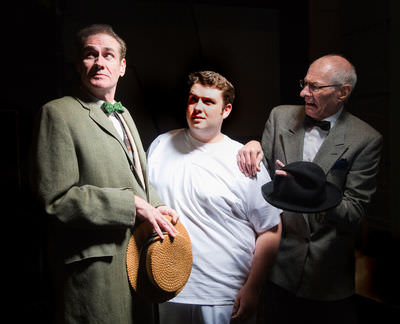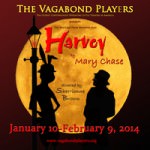A Pooka is coming! And a Pooka is here! The Vagabond Players production of Harvey is going strong; an incredibly fascinating look at the people in our lives and how we respond to them, whether they’re all together sane or not. I took a moment and sat down with Baltimore area Director Sherrionne Brown to get her take on this inspiring classic comedy and just why she was so excited to finally put the enormous oversized rabbit and his good friend Elwood P. Dowd onto the stage. Known for her sensational set design, as well as her intricate attention to detail in every aspect of the shows she directs (most recently including: A Murder is Announced at Cockpit in Court, Private Lives at Vagabond Players, and Equus at Spotlighters Theatre), I wanted to investigate the mastermind behind this brilliant piece of theatre.

Amanda: So the big question is, of all the shows to pick to direct, why Harvey?
Sherrionne: A couple of reasons. First of all, I’ve just always loved the character of Elwood. I mean when people hear Harvey they think ‘oh, the invisible rabbit,’ or they think about the movie and they say, ‘Oh, Jimmy Stewart,’ and that’s because you think about Elwood. And Elwood is this character who has decided to be pleasant. He’s decided to look around and see what’s in front of him, what is right in front of him and to enjoy that. That’s a rare quality.
Also, Roy Hammond (playing Elwood) and I go way back. We go back about 12 or 13 years now. I moved here 14 or 15 years ago from Texas, and he was one of the first people in the area I worked with. We’ve been doing sets together, he’s directed me and I’ve directed him, mostly he’s directed me, but I’ve directed him a couple of times. And we’ve done lots and lots of sets together. But he did Harvey way back when and we talked about and just fell in love with it and I told him, “I would love to direct that someday.” All these years we’ve been trying to do it, I know I’ve said before that those rights were held up for a long time. I kept proposing it and proposing it at different theatres all around Baltimore and we just couldn’t get the rights. But when we finally did get the rights I said “Boom! We’re doing it!” And Roy was right on board with me and off we went.
Do you feel personally connected to Elwood, not in the sense that you’re crazy or are seeing enormous invisible rabbits, but do you find yourself choosing to see the good or choose to see what’s right in front of you the way Elwood does?
You know something; I recently have realized that I am a “glass half-full” person. It’s been tough recently with a lot of the economic recession stuff going on, but that’s made realize that I think I do really think that it’s all going to be ok. And I think in that sense I’m connected to him. I like to see somebody who sees life that way, and chooses to see life that way.
But it’s also when I read a play, if I start visualizing it, then I know I want to do it. And when I read Harvey I could immediately see how I wanted to develop relationships and characters, and how much fun it would be to have the door open, and how would I make that work. How would I get the chair to move, and the chair is not in the script. So I was thinking how much fun it would be to have a chair that moves—originally I was thinking a swivel chair and then I realized it doesn’t matter so long as it moved. It was something that gets moved out of the way so that the audience sees Harvey moving across the stage and not just two doors opening. So when I start visualizing, then I know this is a play that I can sink my teeth into and it will be lots of fun to do. That connects me to everything in the show, knowing that I’ve visualized it.
I had no idea how the playwright wrote this play that has these huge scene changes right in the middle of the acts. I had no idea how I was going to do that. Roy and I brainstormed on that, on how that would be done. But you just know that you’re going to figure it out. It’s like when I did Streetcar over at Spots years ago, I said then I didn’t know how I was going to do the set for that, but I figured it out just like I figured this out, and figuring it out is a challenge, and I love a challenge. Having a challenge really draws me into it as well and these big scene changes right in the middle of the act were definitely a challenge.
Did you find creating this epic set for Harvey to be one of those challenges?
I love being an actor and I love being a director but I have discovered that my identity as a set designer is hugely important to me. Because my sets are hugely important to me. I spend the last couple of weeks, usually more, the actors never see me in anything but paint clothes. I’m there around the clock with no sleep because it really, really, really matters to me, what the sets look like. So I’ve discovered that. That it matters to me.
The colors were challenging. I put a bluish gray on the hospital set at first but then I looked at it and went in and fixed it all up to that brighter color you see now. You know, you work with the lighting designer on stuff like that to make sure it really works. I tend to not plan it all ahead of time. It comes in the moment, and that’s what I really enjoy about it. The fact that I don’t always know what my set is going to look like ahead of time. I might have an idea, a basic idea, but a lot of time because of the budget it’s going to depend on what furniture I can find. What rug or what sofa or what I find, and as soon as I find that then I know where I’m going, but that can be challenging when you do have those budget restrictions to work with.
Now sometimes I’ll create a specific mood, like I knew I wanted the dark woods for the library in Harvey. I knew I wanted all that, but I didn’t know what all that was going to entail specifically until I started finding the pieces. Now that creates a contrast with the much more antiseptic blue of the hospital; and it is the 40s so I didn’t want too much of that institutional olive green, you know what I mean? But on the other hand you want to get that absolutely real feel to it. It was a real challenge that scene, because you had all that white on the stage with the costumes and your first instinct is to do white, but that would have been too much with white on white.
I tend to like the process as much as the finished project. Isn’t that with every major project, the process is the fun part? You don’t always know what you’re going to end up with but taking the journey to get there is where all the fun is at? I don’t have it all pre-planned out when I go in, not the set, not the blocking— now I have some, I know where the exits are and entrances are, so I have that. And I used to do a lot of pre-blocking but now I know that’ not going to hold. Because when you’re watching it you get this gut feeling. The actors themselves will bring something to it, they’ll just know that they should walk over here, or stand over there, or sit in that seat. And if I have it too rigidly preset they don’t get to bring that into it. A lot of it is all created in the rehearsal process, which is another huge challenge, but I do love it.
You’ve mentioned a long working relationship with Roy Hammond, so what was it like getting to bring him into this project as the iconic Elwood character?
He had done it before, but it was so long ago, so I didn’t know if he was even going to want to do it again. I didn’t see the one from before, I mean I’d seen little bits that he has on tape, but I wasn’t sure if he was going to want to repeat this role. I was hoping that we could create something new. I just tried to see what was in front of me, and see what he brought to it and hone that. Roy is a wonderful actor and he brought a lot of experience with him for this. All of my actors are wonderful actors, and there are times when I’ll be sitting there watching them and I’ll find myself saying “oh, I wish I’d thought of that.”
It’s a collaborative effort. Theatre is not just one person, it is definitely a team. You can’t have just one person on it, you have got to be able to be open to ideas and let the actors try stuff. My job as the director is to say “well, you can’t see yourself on the stage, but I can sitting out here, and either yes that does work or no it doesn’t.”
I understand there was a last minute emergency cast replacement, your Doctor Chumley had to be replaced three days before opening night.
Oh, well, that was heartbreaking although it worked out beautifully. Denis Latkowski (originally playing Doctor Chumley) is a long time friend of mine and an area actor. He was in the first show that I directed with Roy, we co-directed a Baltimore Playwrights Festival show called A Certain Mystery at the Paragon Theatre which is now the place where the BROS (Baltimore Rock Opera Society) does their shows. There was a group in there doing plays and we did a BPF show and Denis was in it. We went to the BPF auditions, saw him, and cast him. So I’ve known Denis all these years, and I’ve done many things with him over the years. And he’s such a professional, he learns his lines, he thinks about the characters. I know that this had to be devastating for him, because he would never just drop out of a show, but his health was just such a concern that he had to drop out. I know it was a very difficult decision for him to make.
I’ve worked with Phil Gallagher (currently playing Doctor Chumley) too for a long time. So the night when this happened, the Monday of tech week, we were going back and forth and back and forth about what to do. Denis was actually there and he said “let me try it.” He even got into costume to try and run through it, but he was just so sick. And I’m just sitting there thinking “What am I going to do? We open in four days!” And Phil is the first thing that pops into my head. And I call him up and he said “Let me talk to my wife,” and he called me back a few minutes later and said he could do it. So I said to Denis, “Ok, I’ve got somebody who can do it, what do you want to do?” and Denis just sat there for a moment and thought about it and he finally said “You better tell Phil to go ahead.” It was so hard for him and for me, it was really honestly heartbreaking. And I told Denis later that at least I had the pleasure of seeing him in the role all that time during rehearsal. Him making me laugh every night and I did have that honor and pleasure of that for the whole rehearsal.
And of course Phil is bringing his own take to the character. Phil is hilarious. I didn’t try to mold him into what Denis was doing because they are two different individual actors. And either way I’m incredibly pleased because it really worked out.
You also have a split role assignment for Myrtle Mae. How did that come about?
Karina Ferry (playing Myrtle Mae for most of the production) found out that she had a conflict that she really couldn’t skip out of, so she ran it by me, and said “what can I do? I’ll be there for you, and I don’t want to miss anything in this show.” And I thought about it and I said “Well, if we could get someone like Stephanie Ranno to cover you that one weekend…” and Stephanie had just had a baby not that long ago too, so I know trying to get back into the theatre after having a baby can be hard. But this was perfect for her because she didn’t have to be at all the rehearsals.
Steph and Karina just played with it. And the cast just flowed with it, they really went along with it, whichever one of them was up there, they just worked with them. It’s been a wonderful experience a wonderful experience for me. At first they were both at rehearsals and one of them would be up there and the other one would be watching and you could see them feeding off each other. It was like “oh, what a great idea” and then they would switch places. So they really built the character together which was an interesting thing. The actors are used to both of them, and it’s just worked out really, really great. There are some slight little differences during little moments in certain scenes, but it’s not really that different of an interpretation as a whole for Myrtle Mae because they did build it together. It’s been a fun and different process for me but I liked it.

You’re debuting some new talent in this production – two actors that are new to the Baltimore theatre scene. Tell us about them.
Yes, we do. I believe Colin Holmes, he played Wilson, the male orderly, he’s new. I also think Amy McQuin, she plays Nurse Kelly, she’s also new to the area. They both were at the auditions, I found them there. Colin is very, very funny and he has great timing and lots of energy. He was a lot of fun. Especially for a character that is not very politically correct, I mean not anymore. Nowadays you wouldn’t expect a place like that to have people like that who haul people around and manhandle them and treat them that way. This is very much a period piece on how they thought of mental illness at that time, and this is definitely comic and he really has that comedy. I looked at him in the auditions and went,“Oh, yeah.” Getting new talent in is always fantastic.
Were you worried at all that people coming to see Harvey would either be comparing it to the most recent run on Broadway starring The Big Bang Theory’s Jim Parsons, or that they would be comparing it to Jimmy Stewart’s version from the movie?
I try not to think about that stuff. I do try not to. One of the big worries was that everybody did know the movie and that everybody was going to compare Roy to Jimmy Stewart. But I mean, you can’t do that, you can’t worry about whether or not the audience is going to be making that comparison, you’ve just got to go in and do what you do and be Elwood the way you know how to be Elwood. I think it’s the same thing with the Jim Parsons thing. I mean a lot of people probably didn’t go to Broadway to see that, but even if they did, this is going to be different. I mean every time you do a play, regardless of who you see do it, you’re going to see a different performance, that’s live theatre.
Take Joan Crooks, who plays our Veta, for example. I think Joan completely developed Veta and she isn’t anything like the Veta in the movie. At least not to me. I think she definitely created her own Veta and personally I like her version better. I mean, that’s just me, but I think what they’re creating on stage, Joan and Roy and really everyone in my cast, they’re doing wonderful things that are their own unique things and I love that.
What’s up next when Harvey closes at Vagabonds?
Well I’m directing Incorruptible at Spotlighters Theatre. It doesn’t open for a while yet, April 25, and it runs through the middle of May. Auditions will be coming soon. And yes, I’ll be doing the Set Design for that too, I almost always do my sets when I direct. They are a big part of who I am and a big part of my vision as a Director. It’s going to be a good fun comedy, maybe a little darker than Harvey, but I think it will be a lot of fun. I love creating a set at Spotlighters, in the round, in that space, it’s such a challenge, and it makes you think outside of the box. And I love thinking outside of the box.
I haven’t really had a chance to focus on that yet, when I’m involved in a show it takes up everything I have. Like I said earlier, I’m there round the clock those last few weeks, constantly doing stuff with the set, and getting the show ready to be on its feet. I know people have heard me say that the whole process of doing a show is like a recipe with the audience being the final ingredient. It isn’t complete until you have that final ingredient. And sometimes I feel like the director— even though you’re not supposed to give directions once it’s open. That’s why they run the preview type show in Boston or wherever before a show opens on Broadway. It’s so that the cast can get it in front of an audience— that final ingredient— and they can hone it to perfection.
But with our level of theatre, it’s like you’re supposed to open the show and then the director is supposed to be hands off. And I think that once we have the final ingredient the director needs to be able to go in, at least on opening weekend, and say “ok, now that we have that final ingredient what can we take away from that, what worked and how can we hone it?” I mean I try not to do that too much, but a lot of my actors are still saying “Tell me, tell me,” and they want to hear more and get that final guidance even after we’ve opened. So now that we’ve had that and I can step back, I’m starting to think about Incorruptible and I’m getting very excited.

Any closing thoughts about why you want people to come see your production of Harvey?
Because it’s going to be a wonderful uplifting happy good evening of theatre. To me, unless I’m misreading the audiences, they’re having a good time. And they’re feeling good about everything when they leave. I mean I don’t know if there’s really any other reason to come see it other than that. I mean that’s what you always hope for, that you’re presenting something good. I tend to not do directors notes in the program to the audience. Maybe a little history of the show if it’s important, but I don’t tend to see myself as a writer. My sister writes books, and Amanda, you write, but I don’t see myself as a writer. So I tend to say, “here’s what I’ve done, I hope it presents itself without explanation, without needing something written from me.” So that’s what I’m hoping. That what I’ve come up with comes across in this evening of theatre, and I think it does.
Harvey plays through February 9, 2014 at Vagabond Players—806 South Broadway, in Baltimore, Maryland. For tickets, call the box office at (410) 563-9135, or purchase them online.
LINKs
Review of Harvey on DCMetroTheaterArts.
Read other reviews of Harvey.





